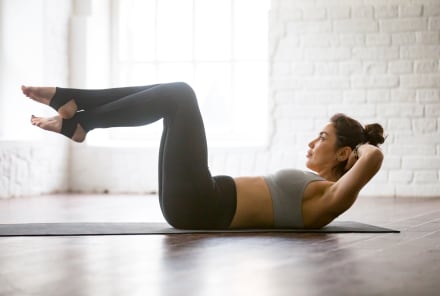Advertisement
Running A Half Marathon? These 6 Strategies Transformed How mbg’s Fitness Editor Trains
Ray Bass is the associate movement and wellness editor at mindbodygreen and a NASM-Certified Personal Trainer. She holds a degree in creative writing from the University of Pennsylvania, with honors in nonfiction.

As the fitness editor of mindbodygreen, I spend a lot of my time working out, and—if you know me—even more time talking about it. But aside from my day-to-day workouts (boxing, spinning, everything), one of my favorite things is training for a race.
Growing up as a year-round athlete, I never had an offseason. I was constantly training for whatever sport came next. And while there were plenty of sprints and laps involved, I never really got to enjoy running during those years, so the second I was done playing team sports, I decided to take up long-distance running.
Now it's been a decade of running, and to say I've learned a few lessons is an understatement. I went from feeling indestructible to feeling like my body was breaking down and betraying me. From the stress fracture in my hip I got from overtraining for the NYC Marathon to the numerous times I've woken up with knee pain (and everything in between), I've had to completely change how I train and recover. Nowadays, I'm way smarter about it.
Here's what I'm doing to train for the half marathon I'm running in March!
Getting runs in but knowing my body's limits.
This one may seem obvious, but logging miles during training does make a difference on race day. Running requires you to use your entire body, from your legs to your core to your mind. That said, over the years, I've learned how easily I tend to overtrain and that I have super-tight leg muscles. This time around, I've cut down my number of runs to two shorter runs and one longer run per week (as opposed to the typical three to five weekly runs).
Cross-training with non-strenuous leg exercises.
The biggest mistake I made when training for the marathon was using my cross-training days to do incredibly intense workouts—think boxing, boot-camp-type classes, and HIIT. These were great for my cardiovascular health, but the high impact and constant change of movement damaged my body in ways I didn't know until I was injured beyond short-term repair.
Everyone is different, but I've found that the best cross-training workouts for me are ones that are strictly cardio or strength (since, if you think about a race, flat-road running is cardio, and running up hills requires strength). I've done a lot of low-impact spin classes and jumping rope. I'll also take some weightlifting classes on leg-and-glute day when I know we're doing controlled movements like squats and lunges, not jumping around or doing something that could injure me. And, hey, the extra strength doesn't hurt when I'm a few miles into a long training run!
The biggest mistake I made when training for the marathon was using my cross-training days to do incredibly intense workouts.
Eating with purpose (without depriving myself).
While in training, I look for foods that can satisfy two goals: 1) rebuild my muscles, and 2) replenish my glycogen stores. This means I stick to a high-protein, moderate-carbohydrate diet.

That said, I'm a human being and I love sweets, so I'm always on the hunt for snacks that indulge my sweet tooth while also giving my body the nutrition and protein it needs to recover. My current favorite is the Peanut Butter Chocolate Chip MacroBar from GoMacro. As a vegetarian, I love that GoMacro bars are plant-based, and they're also vegan, gluten-free, dairy-free, and all organic, so I can eat them knowing that they're serving my body, my training, and my sanity. The best part? They have 11 grams of protein, so they're the perfect post-run refuel! Post-run, they keep me satisfied, heal my muscles with plant-based protein, and refuel my energy stores with healthy carbohydrates. And honestly, because they're so easy to take on the go, I'll sometimes have a bar a few hours before a run, in the middle of the day to hold me over, or I'll have half as a little treat post-dinner because a little dessert never hurt anyone (especially me).
Stretching my calves and hamstrings. Every. Single. Night.
Whenever I go for a run, there's one outcome I can always predict: My calves will be tight afterward. And by now I'm convinced that tight calves and hamstrings are the cause of most of the knee and ankle pain I've experienced—one of my trainers told me recently that tight hamstrings can even cause lower back pain! So you can bet that after every class I take, every run I do, and every night before bed, I am stretching like it's nobody's business, and it makes a world of difference.
From standing calf stretches to pedaling out my heels in a downward dog, I do every calf and hamstring stretch in the book, and it only takes me 10 minutes max. On nights that I don't stretch, chances are I'll wake up with a twinge in my knee, or I'll feel like my calves have seized up overnight. After all the injuries I've had and races I've had to miss, stretching for 10 minutes at night is a small price to pay to ensure I can wake up in the morning feeling fresh and ready to run.
After all the injuries, stretching for 10 minutes at night is a small price to pay to ensure I can wake up in the morning feeling fresh and ready to run.
Taking active rest days.
I used to think active rest days were the fitness world's way of saying you should always be working out. But now, I preach them. Training for any distance race is bound to leave your legs feeling fatigued and sore, and sometimes the best remedy is to get your blood flowing.
Now, I'm not saying you have to go for a shakeout run (I personally never do that), but even going for a short walk can help your muscles heal faster. I live right next to a park, so on the weekends I like to go for a walk outside, which I find both relaxing and rejuvenating. If I don't walk, I'll usually do something very, very low-impact, like a low-impact Pilates class, or a 10-minute yoga flow at home aimed at stretching my legs (think pigeon pose, downward dog). Sometimes my walk is just to the grocery store on Sunday, but hey, that's something!
Enjoying every second.
In the past, when I would sign up for a race, I'd get so caught up in the details of my training—how much I should be running, going faster, running farther, pushing harder—that it ended up flying by and usually led to injury. So when I signed up for this half marathon, I decided to let all of that go.
I committed, instead, to focusing on every run I completed, on my recovery, and on enjoying both. When I set out on my first training run, I was definitely scared of what would happen, but it ended up being perfect. I warmed up, put on some feel-good music, and made sure to embrace and enjoy every single minute. What's the point of putting pressure on myself when I'm doing this half marathon for fun, right?
So that's my best advice: Enjoy every minute. If you focus on that, it's so much easier to train safely, choose the right foods, and find the motivation you need to get through the finish line.

Short On Time? Try This Personal Trainer's 5-Minute Full-Body Workout
Krista Stryker, NSCA-CPT

Short On Time? Try This Personal Trainer's 5-Minute Full-Body Workout
Krista Stryker, NSCA-CPT

Short On Time? Try This Personal Trainer's 5-Minute Full-Body Workout
Krista Stryker, NSCA-CPT

Short On Time? Try This Personal Trainer's 5-Minute Full-Body Workout
Krista Stryker, NSCA-CPT










